Forest Lawn Cemetery (Buffalo)
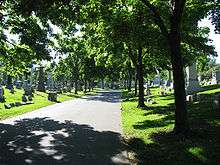 | |
| Details | |
|---|---|
| Established | 1849 |
| Location | 1411 Delaware Avenue, Buffalo, New York 14209 |
| Country | United States |
| Coordinates | 42°55′51″N 78°51′39″W / 42.93083°N 78.86083°W |
| Type | Public |
| Owned by | Forest Lawn Group |
| Size | 269 acres (1.1 km2) |
| Number of graves | 152,000 |
| Website | Forest Lawn.com |
| Find a Grave | Forest Lawn Cemetery |
|
Forest Lawn Cemetery | |
  | |
| Location | 1411 Delaware Avenue, Buffalo, New York 14209 |
| Architect | Clarke, Charles E.; Earnshaw, Joseph |
| NRHP Reference # | 90000688[1] |
| Added to NRHP | May 10, 1990 |
Forest Lawn Cemetery in Buffalo, New York was founded in 1849 by Charles E. Clarke. It covers over 269 acres (1.1 km2) and over 152,000 are buried there, including U.S. President Millard Fillmore, singer Rick James, and inventor Lawrence Dale Bell. Forest Lawn is on the National Register of Historic Places.
Overview
Since its inception, Forest Lawn has served as a cemetery, park, arboretum, and outdoor museum. Monuments, mausoleums and sculptures have attracted visitors for over 150 years. The first sculpture of Seneca Indian chief Red Jacket was erected in 1851. Red Jacket is depicted wearing the richly embroidered scarlet coat presented to him by a British officer, while on his breast is displayed the large silver peace medal awarded to him by President George Washington.[2][3]
Every summer Forest Lawn offers "Sundays in the Cemetery" tours, each with a particular theme. Past examples have included the Pan-American Exposition Trolley Tour, Forest Lawn History Trolley Tour, Forest Lawn History Walk, Civil War Bus Tour and the Forest Lawn Nature Walk.
Margaret L. Wendt Archive and Research Center
In 2014, the 3,140-square-foot (292 m2)[4] Margaret L. Wendt Archive and Resource Center opened within the cemetery. It is a digitized history center, of interment records maintained since 1849,[4] that features a number of interpretive displays highlighting the notable citizens buried in the cemetery. The building features climate controlled rooms and the design of the building mimics some of the historic structure that once stood at the same site.[5] The staff includes Sandy Starks (Interpretive Program Director), John Edens and Lydia Ortiz. Construction and funding for the Center was provided by The Margaret L. Wendt Foundation along with support from The John R. Oishei Foundation.[4]
Mausoleums
In 2004, Frank Lloyd Wright’s 1928 design for the Blue Sky Mausoleum was realized. The Mausoleum contains 24 crypts, which can be purchased and memorialized by individual owners. The Blue Sky Mausoleum is one of three Frank Lloyd Wright memorial sculptures in the world. Sculptor David P. Dowler created a Steuben Glass piece in a limited edition of 26, of which 24 are reserved for those who purchase crypts in the Mausoleum. Crypt clients also receive a copy of architectural historian Richard O. Reisem's 2005 book, Blue Sky Mausoleum of Frank Lloyd Wright.
Other mausoleums in the cemetery include:
- Burgess-Little Mausoleum – designed by H. H. (Henry Harrison) Little.
- Butler Mausoleum – constructed for Edward H. Butler, proprietor of the Buffalo Evening News.
- Buswell-Hochstetter Mausoleum
- Good Mausoleum – constructed for Daniel B. Good, who established the Seibert-Good Company in Chicago, which later consolidated with the Seymour H. Knox stores of Buffalo, N.Y. and finally amalgamated with the F.W. Woolworth Company.
- Goodyear (Frank) Mausoleum – constructed for Frank Henry Goodyear, who, with his brother, Charles W. Goodyear, started the Buffalo and Susquehanna Railroad.
- Kellner Mausoleum – constructed for John. S. Kellner, president of the Crystal Ice and Storage Company.
- Knox Mausoleum – constructed for Seymour H. Knox I, co-founder of F. W. Woolworth Company.
- Laub Mausoleum
- Letchworth-Skinner Mausoleum –
- Mitchel H. Mark Mausoleum – constructed for Mitchell Mark, founder of the Vitascope Theater Company
- Oberkircher Mausoleum – constructed for Caroline Oberkircher and family.
- Pierce (George) Mausoleum – constructed for George N. Pierce who co-founded a company known as Heinz, Pierce and Munshauer for the manufacture of refrigerators, birdcages, iceboxes and bathtubs, until leaving to establish the Pierce Cycle Company, which later became the Pierce-Arrow Motor Car Co.
- Stachura Mausoleum – constructed for Chester and Gloria Stachura.
- Steuernagel Mausoleum – constructed for John Steuernagel, president and board chairman of Kleinhans department store.
- Vars Mausoleum – designed by Lawrence Bley and Duane Lyman. Interred are Harry Thorp Vars, Gertrude Waltho Vars, Mary G. Vars, Addison Foster Vars, Addison F. Vars, Jr., Aline Vars, Carlton J. Balliett, Evelyn Waltho Balliett, Jr., Rose Waltho Brown, Bertha W. Barker, and Estelle Noell Reavis.
- Walden-Myer Mausoleum – designed by Richard A. Waite for Buffalo’s mayor from 1838–39,[6] Ebenezer Walden, and son-in law, Albert J. Myer, recognized by many as the "founder and father" of the US Weather Bureau.[7]
- Willams-Pratt Mausoleum
Gallery
-

John Field sculpture
-
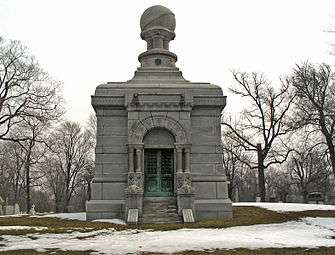
Walden-Myer Mausoleum
-
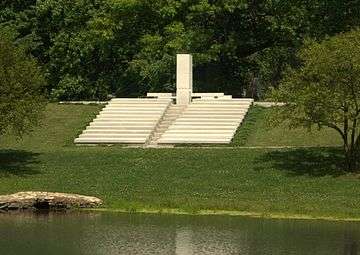
Blue Sky Mausoleum. Designed in 1928 by Frank Lloyd Wright for Darwin D. Martin. Constructed in 2004.
-
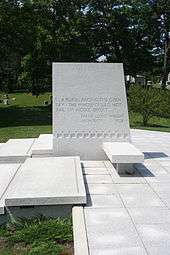
Close-Up of Blue Sky Mausoleum
-
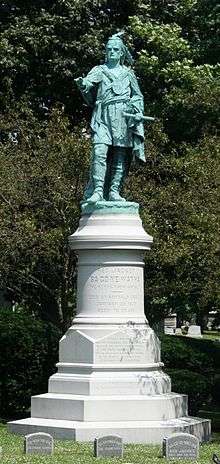
Red Jacket statue
-
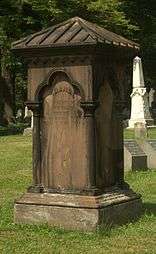
Thomas Crane Monument, 1853.
-
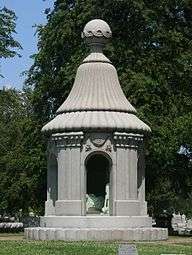
The Blocher Memorial
-
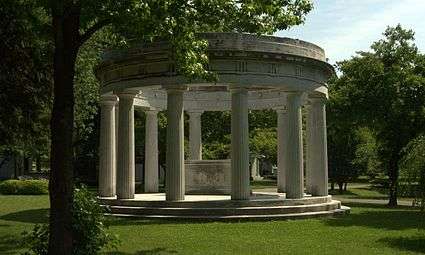
The Birge Memorial by George Cary for George K. Birge, president of the Pierce-Arrow Motor Car Company.
-
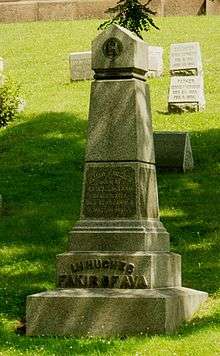
Grave of the Fakir of Ava
-
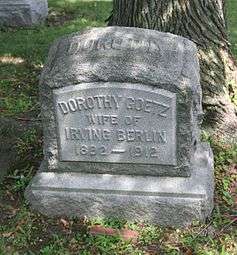
Grave of Dorothy Goetz, wife of Irving Berlin
-
Marker for final resting place of Frederick Cook
-
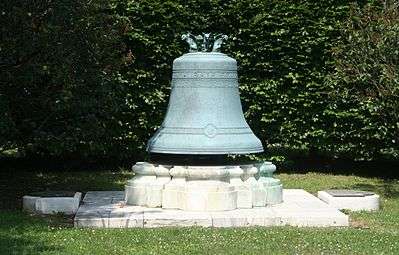
The Oishei Bell, near the entrance to the cemetery
-
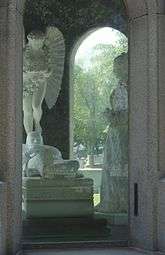
Interior of the Blocher Memorial
-
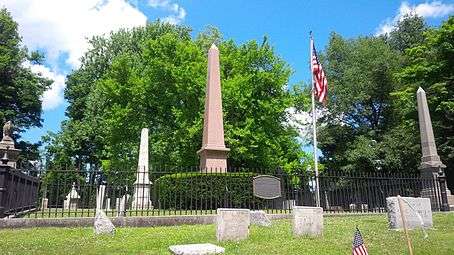
Millard Fillmore grave
-
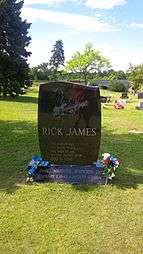
Rick James grave
-
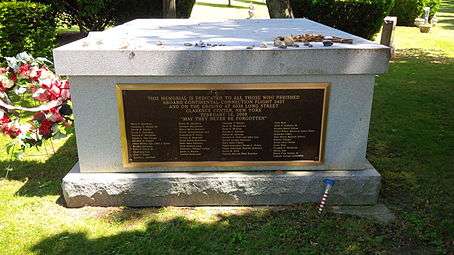
Memorial to the victims of Colgan Air Flight 3407
Others buried here
- Major Andre Andrews – 2nd Mayor of Buffalo
- William Farquhar Barry – U.S. Civil War general
- Hiram Barton – Mayor of Buffalo, 1849–1850, 1852–1853
- Lyman K. Bass – member of the U.S. House of Representatives
- Philip Becker – Mayor of Buffalo, 1876–1877, 1886–1889
- Al Boasberg – comedy writer
- Louise Blanchard Bethune – first female architect
- John Brent – first African-American professional architect in Buffalo
- Willis Carrier – inventor of modern air conditioning
- Shirley Chisholm – American politician, educator, and author
- George William Clinton – Mayor of Buffalo
- Eli Cook – Mayor of Buffalo, 1853, 1854–1855
- Frederick Cook – explorer, physician, and ethnographer
- Lewis P. Dayton – Mayor of Buffalo, 1874–1875
- William Dorsheimer – United States Congressman and Lt. Governor of New York State.
- William Fargo – Mayor of Buffalo, 1862–1865
- Abigail Fillmore – wife of U.S. President Millard Fillmore
- Caroline C. Fillmore – daughter of U.S. President Millard Fillmore
- Barbara Franklin – mother of singer Aretha Franklin
- Dorothy Goetz – first wife of Irving Berlin
- Townsend Griffiss – first US aviator to be killed in World War II, 1900-1942
- Anna Katharine Green – American poet and novelist
- Anson Goodyear – first president of the Museum of Modern Art
- Charles W. Goodyear – co-founder of the Great Southern Lumber Company
- Nathan K. Hall – member of the U.S. House of Representatives
- Red Jacket – Native American Seneca orator and chief of the Wolf clan.[8]
- Rick James – American musician and composer (1948 –2004)
- Edward Austin Kent – Buffalo architect who perished aboard the RMS Titanic (1854-1912)
- Jesse Ketchum - Canadian politician and tannery owner in Toronto and Buffalo
- William Ketchum – Mayor of Buffalo, 1844–1845
- John D. Larkin – owner and founder of the Larkin mail order company, 1845-1926
- Timothy T. Lockwood – Mayor of Buffalo, 1858–1859
- John C. Lord – Presbyterian minister and activist
- George Maltby Love – 1831-1887 Civil War Medal of Honor Recipient
- Mitchell Mark – pioneer of motion picture exhibition
- Darwin D. Martin – Larkin Company executive and commissioner of the Darwin D. Martin House
- Joseph G. Masten – Mayor of Buffalo, 1843-1844 & 1845-1846
- William McMillan – Buffalo's first Superintendent of Parks.
- Dr. Roswell Park – founder of Roswell Park Cancer Institute
- Ely S. Parker – Seneca attorney, engineer, and tribal diplomat
- Kristen Pfaff – ex-bassist of Hole (band)
- Hiram Pratt – Mayor of Buffalo
- Bennett C. Riley – US Army General and last military Governor of California
- Charles Rohlfs – American actor, patternmaker, stove designer and furniture maker
- Charles Cary Rumsey – sculptor
- Henry K. Smith – Mayor of Buffalo, 1850–1851
- Alfred P. Southwick – steam-boat engineer, dentist and inventor of the first electric chair
- Elbridge G. Spaulding – American lawyer, banker, and politician.[9]
- Alfred P. Stone – member of the U.S. House of Representatives
- Mary Burnett Talbert
- Sheldon Thompson – Mayor of Buffalo
- Josiah Trowbridge – physician and Mayor of Buffalo
- Richard A. Waite – British-born American architect
- John B. Weber – Civil War colonel and United States Congressman, 1885–1889
- Chandler J. Wells – Mayor of Buffalo, 1866–1867
- Samuel Wilkeson – industrialist and Mayor of Buffalo
- Joseph Willcocks – former member of the Legislative Assembly of Upper Canada and Major in the Canadian Volunteers (US Army) during the War of 1812
- 17 unidentified victims of the Angola Horror
References
- ↑ National Park Service (2010-07-09). "National Register Information System". National Register of Historic Places. National Park Service.
- ↑ http://www.forest-lawn.com/Pages/about.html
- ↑ "Cultural Resource Information System (CRIS)" (Searchable database). New York State Office of Parks, Recreation and Historic Preservation. Retrieved 2016-05-01. Note: This includes John A. Bonafide (March 1990). "National Register of Historic Places Registration Form: Forest Lawn Cemetery" (PDF). Retrieved 2016-05-01., Accompanying photographs, and Accompanying captions
- 1 2 3 Nussbaumer, Newell (November 19, 2013). "Forest Lawn's Margaret L. Wendt Archive & Resource Center". Buffalo Rising. Retrieved 16 February 2016.
- ↑ Nussbaumer, Newell (September 20, 2014). "The Margaret L. Wendt Archive and Resource Center". Buffalo Rising. Retrieved 16 February 2016.
- ↑ http://www.buffalonian.com/history/industry/mayors/Walden.htm
- ↑ http://www.wbuf.noaa.gov/ajmyer.htm.
- ↑ Maine League of Historical Societies and Museums (1970). Doris A. Isaacson, ed. Maine: A Guide 'Down East'. Rockland, Me: Courier-Gazette, Inc. pp. 260–261.
- ↑ Mr. Spaulding and Greenback Resumption (1875, October 16). In The Commercial and Financial Chronicle (Vol. XXI, p. 358). New York, NY: William B. Dana.

